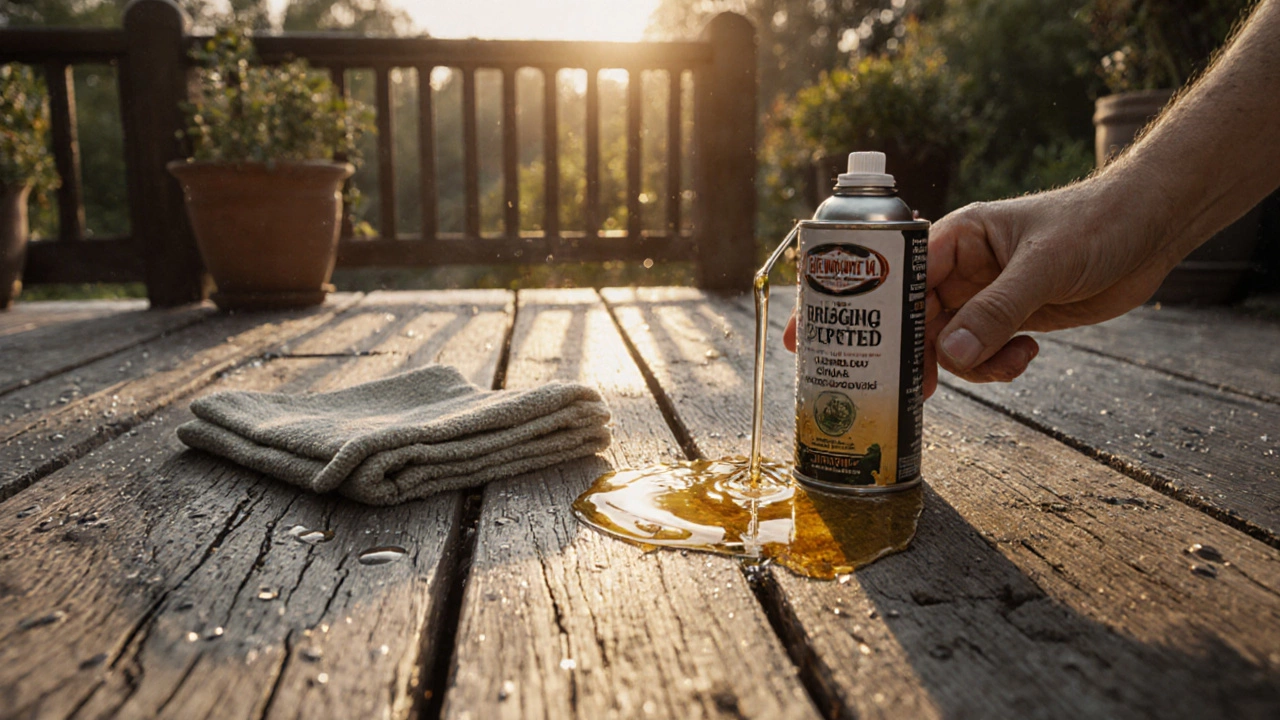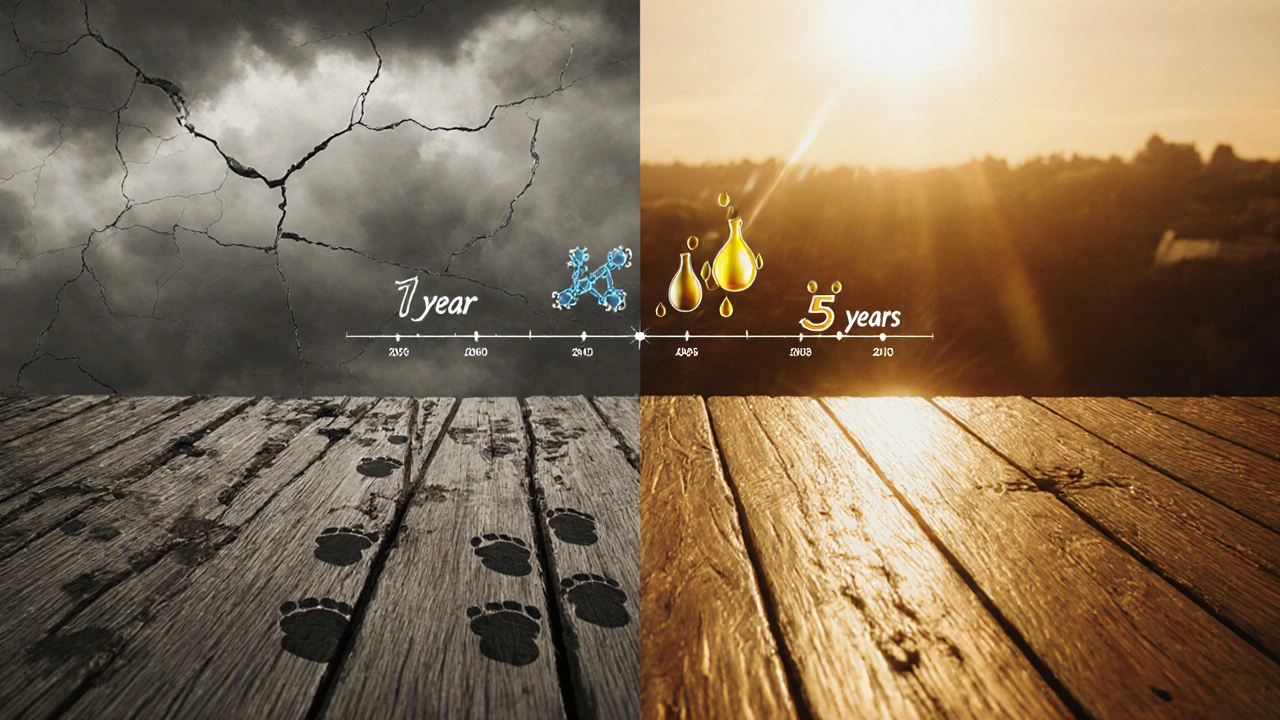How Often Should You Oil Your Terrace? A Practical Guide for Lasting Wood Protection

How Often Should You Oil Your Terrace? A Practical Guide for Lasting Wood Protection
Terrace Oiling Frequency Calculator
How Often Should You Oil Your Terrace?
Answer these questions to get your personalized oiling schedule based on real-world conditions.
Water Bead Test Guide
When your terrace needs oiling, water will soak in within 10 seconds. If it beads up and rolls off, oil is still effective.
If you’ve ever stepped barefoot on your terrace in the morning and felt rough, cracked wood under your toes, you know oiling isn’t optional-it’s survival. Oiling your terrace isn’t about making it shine; it’s about keeping it alive. Wood exposed to sun, rain, snow, and foot traffic breaks down fast. Without oil, your terrace doesn’t just look old-it starts to splinter, warp, and rot. The question isn’t if you should oil it, but how often you should do it to avoid costly repairs or replacements.
Why Oil Your Terrace at All?
Wood terraces are usually made from hardwoods like teak, ipe, or cedar, or pressure-treated pine. These woods are durable, but they’re not indestructible. Sunlight bleaches the color and dries out the natural oils. Rain soaks in, swells the fibers, and then freezes in winter, causing cracks. Foot traffic grinds away the surface. Oiling creates a protective barrier that repels water, blocks UV rays, and keeps the wood flexible.
Think of it like sunscreen for your skin. Skip it for too long, and the damage adds up. A well-oiled terrace lasts 15-20 years. A neglected one? You’re looking at replacement in 5-8 years. That’s a $5,000-$15,000 difference depending on size and material.
How Often Should You Oil Your Terrace?
The short answer: every 1-2 years. But that’s not the full story. The real frequency depends on three things: your climate, how much foot traffic your terrace gets, and the type of oil you use.
- Hot, sunny, dry climates (like Arizona or Southern California): Oil every year. UV exposure dries wood out fast.
- Wet, rainy, humid climates (like the Pacific Northwest or Florida): Oil every 1-1.5 years. Water is the bigger enemy here, so you need to reapply before mold and rot set in.
- Four-season climates (like the Midwest or Northeast): Oil every 1.5-2 years. Freeze-thaw cycles are brutal on wood. Fall is the best time to oil before winter hits.
- High foot traffic (family gatherings, pets, kids playing): Oil annually. Wear and tear strips away the oil faster.
- Low traffic (quiet reading nook, occasional use): You might stretch it to two years-but don’t skip the inspection.
There’s a simple test to know when it’s time: Pour a few drops of water on the wood. If it beads up and rolls off, your oil is still working. If it soaks in within 10 seconds, it’s time to reapply. No guesswork needed.
What Kind of Oil Should You Use?
Not all oils are created equal. You’re not just buying oil-you’re buying protection. Here’s what actually works:
- Teak oil: Popular, but misleading. Most "teak oil" is a blend of linseed oil, varnish, and solvents. It dries hard and can peel over time. Good for occasional use, but not ideal for high-traffic areas.
- Penetrating wood oil (like tung oil or linseed oil): These soak deep into the wood fibers. They don’t form a film, so they won’t peel or flake. Tung oil is more water-resistant and lasts longer. Linseed oil is cheaper but takes longer to dry and can go rancid if low-quality.
- Oil-based deck sealers with UV inhibitors: These are your best bet for most homeowners. Look for products labeled "penetrating oil finish with UV protection." Brands like Cabot, Armstrong Clark, and Ready Seal are proven in real-world conditions.
- Avoid water-based sealers: They sit on top of the wood and peel. They look nice at first, but they trap moisture underneath and cause rot.
Check the label. If it says "water-based," "spray-on," or "clear gloss," walk away. You want something labeled "penetrating," "natural oil finish," or "semi-transparent stain with oil base."

When’s the Best Time to Oil?
Timing matters more than you think. Oil doesn’t work if it rains right after you apply it. You need dry, stable weather.
- Spring or early fall are ideal. Temperatures between 50°F and 85°F. No rain forecasted for at least 48 hours.
- Avoid summer: High heat makes oil dry too fast, leaving streaks and uneven coverage.
- Avoid winter: Cold wood won’t absorb oil. The oil just sits on top and wipes off.
- Check the humidity: If it’s above 70%, wait. Moisture in the air slows drying and invites mold.
Plan your oiling for a weekend when the forecast is clear. Don’t rush it. Let the oil soak in for at least 4 hours before walking on it. Wait 24 hours before placing furniture or plants back.
How to Oil Your Terrace Right
Bad application is worse than no oil at all. Here’s how to do it right:
- Clean first. Sweep away debris. Wash with a deck cleaner (not bleach). Use a stiff brush to scrub the surface. Rinse well. Let it dry for at least 48 hours. Wet wood won’t absorb oil.
- Test a small spot. Apply oil to a hidden corner. Wait 24 hours. If it looks even and darkens the wood evenly, you’re good.
- Use the right tools. A paint pad or lambswool applicator works best. Avoid brushes-they leave streaks. Rollers are too aggressive and trap air bubbles.
- Apply in thin coats. One coat is enough for most woods. Pour oil onto the surface, then spread it evenly. Don’t pile it on. Excess oil doesn’t soak in-it just sits there, sticky and attracting dirt.
- Wipe off excess. After 30-45 minutes, go over the surface with a clean, dry cloth. Remove any puddles. Leftover oil turns sticky and becomes a breeding ground for mold.
- Let it cure. Wait 24-48 hours before using the terrace. Longer in cool or humid weather.
Pro tip: Oil the underside of railings and the edges of boards. These areas dry out fastest and are often forgotten.
Signs You’re Oiling Too Often-or Not Enough
Over-oiling is a real problem. Too much oil builds up, becomes sticky, and attracts grime. You’ll see a greasy film, or the wood looks shiny instead of natural. If that’s happening, you’re applying too often or using the wrong product.
Under-oiling shows up as:
- Wood turning gray or silver
- Surface feels rough or fuzzy
- Water soaks in instantly
- Small cracks or splits appear
If you see any of these, don’t just reapply oil. Clean the wood first. Old, dirty oil traps moisture and makes the problem worse.

What Happens If You Never Oil Your Terrace?
It doesn’t just look bad-it becomes dangerous. Dry, cracked wood splinters easily. Wet wood turns slippery with mold. Rot can spread under the surface. You might not notice until a board gives way underfoot.
One homeowner in Ohio replaced his entire 200-square-foot terrace after 7 years because he never oiled it. He thought "it was fine." The cost: $8,200. He could’ve spent $300 a year on oil and saved $7,900.
Wood terraces are an investment. Oiling is the cheapest insurance you’ll ever buy.
Quick Maintenance Checklist
- Inspect your terrace every spring and fall
- Do the water test: if it soaks in fast, it’s time to oil
- Use a penetrating oil with UV protection
- Clean before applying oil
- Apply in dry, mild weather
- Wipe off excess oil after 30 minutes
- Wait 24-48 hours before using
Stick to this, and your terrace will look great, feel safe, and last for decades.
Can I use olive oil or coconut oil on my terrace?
No. Kitchen oils like olive or coconut oil aren’t designed for outdoor wood. They go rancid, attract insects, and don’t protect against UV or water. They’ll turn sticky, smell bad, and make your terrace worse over time. Stick to products made for outdoor decks.
Do I need to sand my terrace before oiling?
Only if the surface is rough, splintered, or has old paint or sealer. For regular maintenance every 1-2 years, cleaning is enough. Sanding removes the top layer of wood and should only be done once every 5-7 years, or if you’re restoring a neglected terrace.
Is it okay to oil a new terrace right away?
Wait at least 4-6 weeks after installation. New wood needs time to dry out from the milling and shipping process. Oiling too soon traps moisture inside, which leads to warping and mold. Check with your supplier-they usually recommend a waiting period.
How much oil do I need for a typical terrace?
Most penetrating oils cover 150-200 square feet per gallon. A standard 12x16-foot terrace (192 sq ft) needs about one gallon for one coat. Always buy a little extra. It’s better to have too much than to run out halfway through.
Can I oil my terrace in the shade?
Yes, but it’ll take longer to dry. Direct sunlight helps the oil cure faster and more evenly. If you’re working in shade, give it at least 48 hours before walking on it. Avoid oiling on cloudy, damp days-even if it’s shaded.
Next Steps: Make a Plan
Don’t wait until your terrace looks bad. Set a reminder on your phone: "Oil terrace-next spring." Keep a bottle of oil and a clean cloth on the shelf. When you see the water test fail, act fast. The difference between a beautiful terrace and a broken one isn’t luck-it’s consistency.
About
Gardener Support India is your go-to online destination for expert advice on gardening and horticultural services in India. Whether you're a beginner or an experienced gardener, our platform offers extensive resources, tips, and support tailored to Indian climates and plant species. Explore a wide range of guides on plant care, sustainable gardening practices, and innovative gardening solutions. Connect with local experts to enhance your gardening experience and maintain a flourishing garden. Our dedicated services aim to empower Indian gardeners with the knowledge and tools needed for a successful gardening journey.
Latest Posts


How to Safely Stabilize Sloped Soil for Terrace Gardening
By Alden Thorne Mar 9, 2025

Two Drawbacks of Green Roofs You Should Know
By Alden Thorne Oct 8, 2025

Composting Drawbacks: Real Issues, Surprising Facts, and Smart Tips
By Alden Thorne Jul 4, 2025

Write a comment